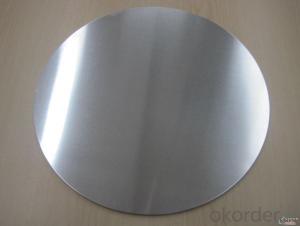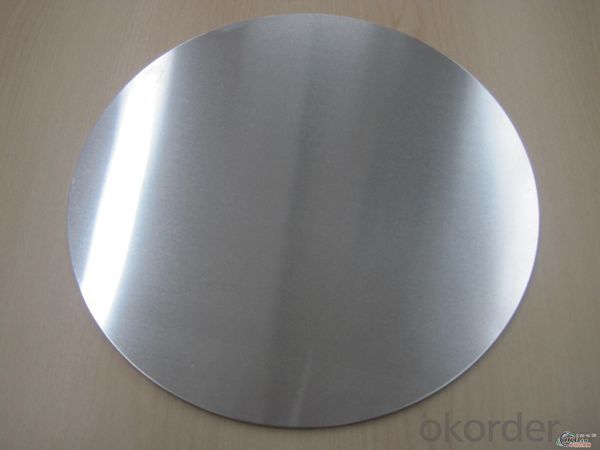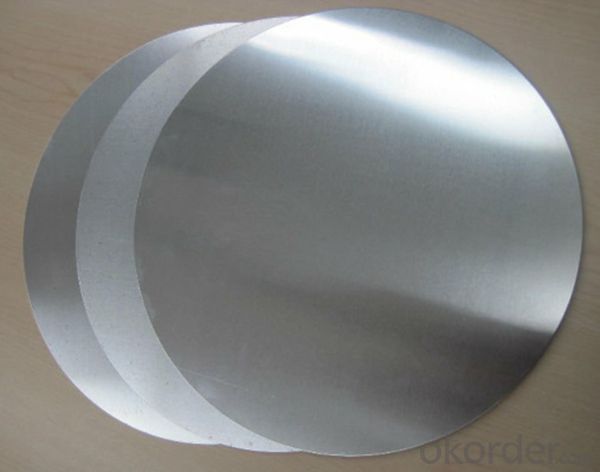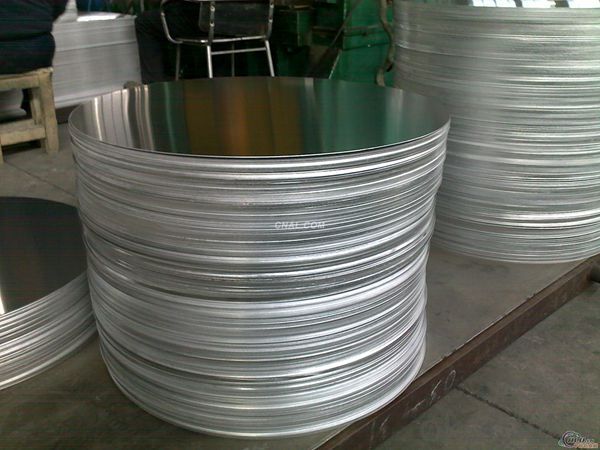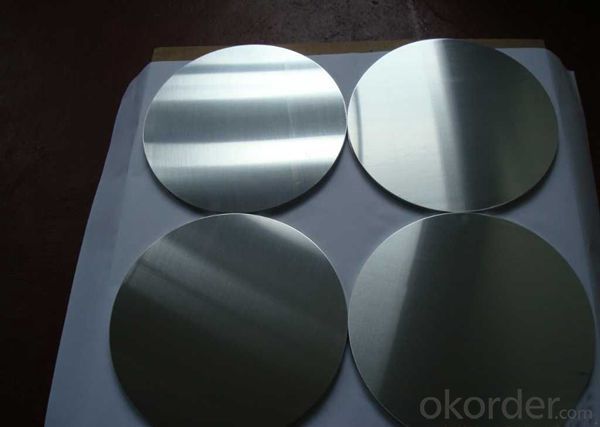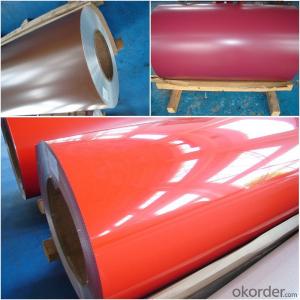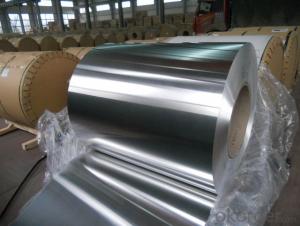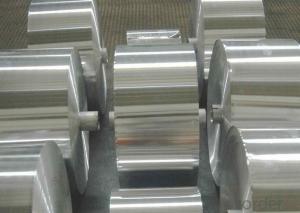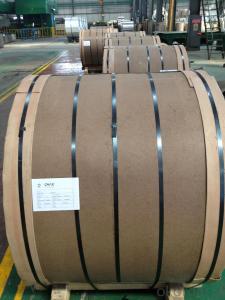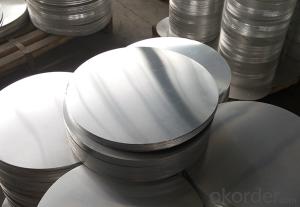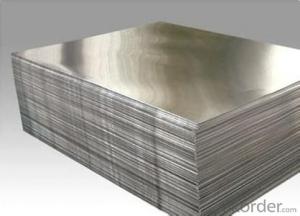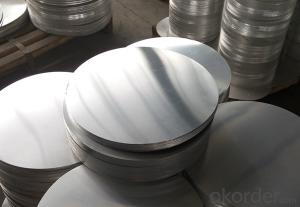5000 Series Mill Finish Aluminum Circle Panel with Aluminum Oxide Sandpaper Sheets
- Loading Port:
- China main port
- Payment Terms:
- TT OR LC
- Min Order Qty:
- 5 m.t.
- Supply Capability:
- 360 m.t./month
OKorder Service Pledge
OKorder Financial Service
You Might Also Like
Specification
5000 Series Mill Finish Aluminum Circle Panel
Hot rolled aluminum circle deep drawing quality for cookware is mainly used for general commercial and industrial uses, like the capacitor case, toothpaste case, medical tubes, kitchen ware, spray bottle, cosmetic case. With high quality casting and rolling coils or hot-rolled coils as raw meterials, it goes through different cold rolling deformation, slitting, annealing and finally stamping into an aluminum disc, then packaging for delivery.
l Specification
Certificate | ISO9001:2008 ISO 14001:2004 OHSAS 18001:2007 | |||||||||||
Product Name | 1050 Aluminum circle price for cookware | |||||||||||
Hardness state | H14, H16, H18, H22,H24, H26, H22 ,H32,H34 and “O”. | |||||||||||
Product Size | Thickness: 0.3-68.0mm, Diameter: 20-1030mm | |||||||||||
Surface Treatment | mill finished | |||||||||||
Processed | Deep drawings | |||||||||||
Min order quantity | 5 tons | |||||||||||
Short lead time | 20 days | |||||||||||
Application | Cookware, Electrical Appliances | |||||||||||
Month Capacity | 5000 tons | |||||||||||
Chemical Composition (WT.%) | ||||||||||||
Alloy | Min.AL | Si | Fe | Cu | Mn | Mg | Cr | Ni | Zn | Ca | ||
1050 | 99.5 | 0.25 | 0.4 | 0.05 | 0.05 | 0.05 | --- | --- | 0.05 | --- | ||
1060 | 99.6 | 0.25 | 0.35 | 0.05 | 0.03 | 0.03 | --- | --- | 0.05 | --- | ||
1070 | 99.7 | 0.25 | 0.25 | 0.04 | 0.03 | 0.03 | -- | --- | 0.04 | --- | ||
1100 | 99 | 0.95 | 0.95 | 0.05-0.2 | 0.05 | --- | -- | --- | 0.1 | --- | ||
Mechanical Properties | ||||||||||||
TEMPER | THICKNESS(mm) | TENSILE STRENGTH | ELONGATION% | |||||||||
HO | 0.55-5.50 | 60-100 | ≥ 20 | |||||||||
H12 | 0.55-5.50 | 70-120 | ≥ 4 | |||||||||
H14 | 0.55-5.50 | 85-120 | ≥ 2 | |||||||||
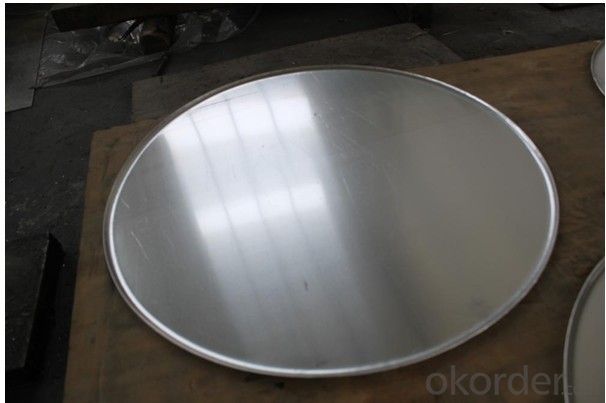
FAQ
1. How can I get some samples?
We are honored to offer you samples. New clients are expected to pay for the courier cost. The samples are free for you.
2 Do you have any certificates?
Our products passed inspection of SGS, FDA, and CE Quality is priority! Every worker keeps the QC from the very beginning to the very end, Quality control department especially responsible for quality checking in each process.
3 Can your factory print or emboss my logo on the goods?
Yes, we can print or emboss the logo on the goods or their packing box.
4 What information should I let you know if I want to get a quotation?
1) The specification of products (length x width x thickness);
2) The temper and alloy.
3) The final product you will use to be made
4 It will be better if you can show us the pictures or design sketch. Samples will be best for clarifying. If not, we will recommend relevant products with details for reference.We usually produce goods based on customers
Samples or based on customers’ picture, logo, sizes etc.
- Q: How do you join aluminum sheets together?
- One common method to join aluminum sheets together is through welding. This involves melting the aluminum at the joint and then allowing it to solidify, creating a strong bond. Other methods include using adhesive bonding, riveting, or using mechanical fasteners such as screws or bolts. The choice of joining method depends on factors such as the application, the thickness of the aluminum sheets, and the desired strength and appearance of the joint.
- Q: Are aluminum sheets resistant to rust?
- Indeed, the resistance of aluminum sheets to rust is remarkably high. This is due to the natural formation of a protective oxide layer on the surface of aluminum when it comes into contact with air, thereby hindering further corrosion. In contrast to iron or steel that can rust in the presence of moisture and oxygen, aluminum does not necessitate any supplementary coatings or treatments to safeguard against rust formation. Consequently, aluminum sheets are widely favored across various sectors such as construction, automotive, and marine industries, where the prevention of rust is imperative.
- Q: Are aluminum sheets suitable for architectural facades?
- Yes, aluminum sheets are highly suitable for architectural facades. They offer numerous benefits such as durability, lightweight construction, corrosion resistance, and versatility in design. Aluminum sheets can be easily shaped and formed into various sizes and shapes, allowing for creative and unique architectural designs. Additionally, their ability to withstand harsh weather conditions makes them a reliable choice for long-lasting facades.
- Q: I want to make a part using molten aluminum with a hole through the middle and would like to use a steel rod to do this. Would the bar stick to the aluminum when it cools and not be able to be removed? If so is there so type of coating I can use so it can be removed?
- Unless the surface was specially prepared the aluminum won't bond to the steel. To be sure it doesn't, simply 'smoke ' the steel with a candle etc. (thin layer of carbon black), to ensure no bonding. Your problem will come from the different co-efficients of expansion. The aluminum will shrink more than the steel in cooling and will grab that rod very tightly. Your hole, ( therefore your rod), will have to have a considerable taper if you ever hope to drive that rod out of the casting. Caution- You are aware that most aluminum alloys will burn in air at pouring temperatures aren't you?
- Q: Can aluminum sheets be an alternative to plastic in certain applications?
- Yes, aluminum sheets can indeed be an alternative to plastic in certain applications. Aluminum is a highly versatile and sustainable material that offers several advantages over plastic, such as being more durable, resistant to UV rays, and having a longer lifespan. Additionally, aluminum is recyclable and can be reused indefinitely, making it a more environmentally friendly choice. However, the suitability of aluminum sheets as an alternative to plastic would depend on the specific application and requirements.
- Q: How much should I be charged to have aluminum siding installed? I have a two floor single family home which is detached. I also would want new gutters installed and soffets (i think that is what they are called). One company estimated 12k and another said 10K. This would entail just putting the siding over the original siding. Any answers are appreciated.
- You have no say in the matter. The insurance company is paying the contractor to remove and dispose of the old siding. They don't care if the contractor makes a few hundred bucks selling the siding as scrap and neither should you.
- Q: What is the difference between aluminum plate AL1050 and AL1060?
- 1050 and 1060 belong to an aluminum plate, that is, pure aluminum plate, the difference is that the content of aluminum is different. 1050 aluminum content 99.95%, 1060 Aluminum Content 99.60%, material is very close, often can replace the use, the current use is more than 1060 Aluminum plate.Is the aluminum plate with a thickness of more than 0.2mm to 500mm, 200mm width, length less than 16m aluminum material called aluminum plate or aluminum sheet, aluminum is below 0.2mm, 200mm within the width of the row material or bar (of course, with the progress of the large equipment, the width can be 600mm row material also more). Aluminum sheet refers to the rectangular plate made of aluminium ingot rolled and divided into pure aluminum plate, alloy aluminum plate, thin aluminum plate, middle thick aluminum plate and pattern aluminum plate.
- Q: I have a problem when machining aluminium in my machine shop. There are times when the machines aluminium surface turns yellowish (somtimes brown). I do not know what is the main cause of the problem. Is it due to the coolant used?
- Aluminum oxides may appear in different colors depending on hydration states and other variables. Look in a CRC Handbook of Chemistry Physics if available for aluminum compounds and their colors. The colors that you see may also have as much to do with the surface finish as the color of the material on the surface. A microscopically rough surface will appear dark next to a polished surface due to light scattering. I will agree with Ling in principle, but not on details. EDS detection limits on homogeneous samples can be better than 0.1%, although not so good for elements at the light end of the detection range. Current detectors can detect chlorine (a common culprit for aluminum discoloration) at about 0.1%. Your problem with detection and one that Ling has addressed previously may be that a thin film of contamination would not be easily detected by EDS. As Ling suggests, SIMS is a good technique for detecting thin films and low concentrations. The problem with SIMS in this case may be that the detection limits are too good and the technique cannot be quantified. SIMS would detect 2 ppm of chloride and you couldn't tell for sure whether it was 2 ppm, which is probably not an issue here, or 2000 ppm, which would be significant. I would suggest x-ray photoelectron spectroscopy (ESCA or XPS) as an alternative for further study. The technique will analyze thin films (20 A) and detection limits are good enough (about 0.1%). In addition, XPS will give you information about the compounds present, e.g. whether the oxygen is aluminum oxide, aluminum hydroxide, etc. Good Luck.
- Q: How do aluminum sheets compare to copper sheets in terms of conductivity?
- Aluminum sheets and copper sheets differ in terms of conductivity. Copper is known to be an excellent conductor of electricity, being one of the most conductive metals available. It has a high electrical conductivity, which means it allows electricity to flow through it with minimal resistance. On the other hand, aluminum is also a good conductor of electricity, but it is not as conductive as copper. Aluminum has approximately 61% conductivity compared to copper. Therefore, if high conductivity is a primary requirement, copper sheets would be the better choice. However, if cost-effectiveness and lightweight properties are more important, aluminum sheets can still provide sufficient conductivity for many applications. Ultimately, the choice between aluminum and copper sheets depends on the specific needs of the project and the balance between conductivity, cost, and other factors.
- Q: This question asks for the common types of aluminum sheet windows and doors that are available in the market.
- <p>Common types of aluminum sheet windows and doors in the market include sliding windows, casement windows, fixed windows, and awning windows. For doors, there are sliding doors, swing doors, folding doors, and automatic doors. Each type has specific features and applications, such as sliding windows being space-saving and easy to operate, while casement windows offer better ventilation. Sliding doors are popular for their smooth operation and minimal space requirement, and swing doors are traditional and widely used for their durability and security. These aluminum products are valued for their strength, durability, and low maintenance requirements.</p>
Send your message to us
5000 Series Mill Finish Aluminum Circle Panel with Aluminum Oxide Sandpaper Sheets
- Loading Port:
- China main port
- Payment Terms:
- TT OR LC
- Min Order Qty:
- 5 m.t.
- Supply Capability:
- 360 m.t./month
OKorder Service Pledge
OKorder Financial Service
Similar products
Hot products
Hot Searches
Related keywords
